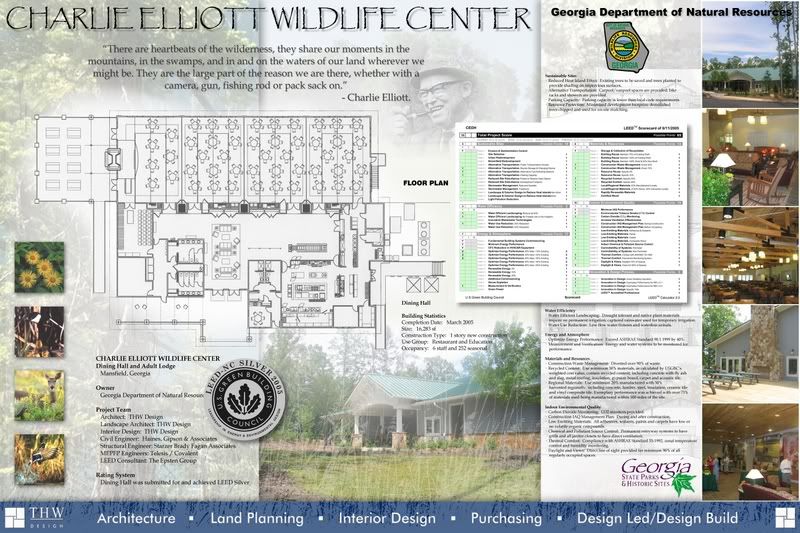Tuesday, May 29, 2007
Integrating Sustainable Design
The side bar, “Tools for the Task,” outlines a couple of the reference design tools available to the industry and I am versed with the opportunities that the USGBC LEED Rating System can provide, (see previous blog entries on the Charlie Elliott Wildlife Center a LEED Silver Building designed by THW). and the GGHC – Green Guidelines for Healthcare. Although the GGHC is geared more towards Hospital design and USGBC is piloting a LEED for Healthcare System of their own, both can be applied towards Senior Care Facilities and to help this effort THW is working on a Sustainable Checklist for Senior Facilities to accomplish those goals – this can also be viewed within an earlier blog entry.
Please take the time to read this article and feel free to contact me with any questions or comments as THW would like to assist in any way possible to keep this overall industry movement moving forward.
Greening THW: a Paradigm Shift
In conjunction with this paradigm shift, we are conducting firm wide education seminars to bring awareness to all of our staff so that Green Design and the principles of Vitalife become second nature to all of us. I have attached a couple of the presentations for your viewing pleasure, should you have any questions or comments – I would be more than happy to discuss them with you.
Wednesday, January 24, 2007
Friday, January 19, 2007
Sustainable Checklist
Sustainable Checklist for Senior Living
There are numerous Green Metrics, sustainable guidelines that can be used as a design tool or for actual third party verification, on the market these days. Despite all these efforts such as LEED, Green Guidelines for Healthcare and Global Green, the Senior Living arena seems to have been left out of the mix. The attached document is the beginning of what we at THW see as a promising way to integrate sustainable strategies into all of our projects. The Sustainable Checklist is the culmination of green credits/strategies derived from a review of the afore mentioned green metrics and proper citation of those metrics is warranted as this checklist is based on all the hard work and research of those parties that have created them – only to have been rearranged in a manner that we feel is best suited for the senior living market. The Checklist has been arranged in seven basic categories of Sustainable Sites, Water Efficiency, Energy & Atmosphere, Materials & Resources, Indoor Environmental Quality, Integrated Design & Operation and Innovation. If you are familiar with any of the more prominent green metrics, these categories will look familiar – however we have taken this outline and gone one step further with the inclusion of three different levels of commitment. The Three Levels of Commitment are: Strategies for Standard Practice – those strategies that will be implemented on all projects no matter what, Strategies to be Considered – those strategies that would be addressed should a project choose to be green, an energy efficient environmentally conscious project, but do not want to go to the edge and still afford many choices of what strategies to employ, and finally Strategies for Ultimate Green – those strategies that would create a project that is worthy of merit as a truly sustainable project that is a product of the latest strategies and technologies a showcase of green design. Any project can choose which level to pursue depending on how “green’ the project wants to be or if there is a particular area of concern that area can have a concentration of effort as opposed to another area that may not be as big a concern. This extra level of breakdown allows for greater flexibility within the application of the Sustainable Checklist.
This document is intended to be a living document and offered for review and comment. There is on going research being conducted to investigate the validity and application of these strategies as they apply to senior living as a project type. Please see other entries within this blog for further information on that research or you can contact me and I will assist in any way I can.
Green & Sustainable Strategies
I am looking for individuals on the Owner side who would be willing to assist with this research. I will be formulating various questionnaires on different subjects and would request that you provide the requested information. I will then take this information and include it within the resultant document with appropriate citations. If you would like to participate in this research, please respond within the blog with your name and contact info and I will keep you abreast of the forthcoming questionnaires.
Thank you,
Donald Green, AIA, LEED AP
THW Design
Indoor Environmental Quality
Indoor Environmental Quality is very important within Senior Living Facilities, especially during and directly after construction. Attached is a document that can lay the groundwork for a good IEQ Plan for any facility looking to either expand or produce new construction. The document is the culmination of a great deal of research along with on site observations through the various projects I have been involved with. An IEQ Plan requires a coordinated effort from all parties top to bottom, from the Owner down to the sub-contractor in the field. A concerted awareness is necessary to maintain a high level of consciousness when implementing the standards and techniques the project team ultimately agrees on.
For more information follow the link, and select IEQ Plan 8-18-05...

